| 1 | Kenya and Ethiopia’s spitting cobra |
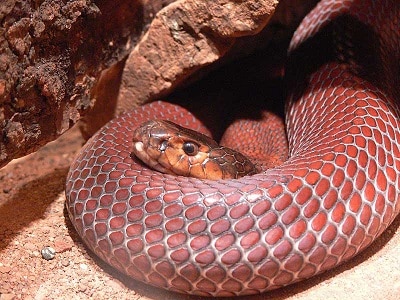
East Africa has its fair share of deadly snakes you should stand well back from. There’s crushing puff adders lurking by forest game trails, waiting to attack people leaving their safari vehicles. There’s glaring bush vipers, resting on branches quietly and guarding the slopes of tourist attractions like Mount Kenya. But there’s one creature that even standing back won’t save you from – the red spitting cobra (Naja pallida).
Worldwide, there are 19 species of true spitting cobra, all belonging to the genus of Naja. Africa has 6 or 7, and red spitting cobras are the main species of the east. Kenya, Ethiopia and Somalia are their heartlands, where you’re likely to encounter one simply by putting your washing on a line, or going for a walk. But they also appear in Djibouti, parts of South Sudan, and far northern Tanzania, where they’re fairly common.
Red spitting cobras not only have a venomous bite, but the ability to fire venom globules, due to pressurised holes in their fang tips. It’s this which makes them double the threat compared to the brown forest cobra, another species found in east Africa. Like any cobra, red spitting cobras are fast and twitchy, and require no excuse to launch a full scale attack on human beings.
Originally, red spitting cobras were listed as appearing in Egypt, but those populations are now an independent species: the Nubian spitting cobra (Naja nubiae).
| 2 | Spits 20 times without weakening |
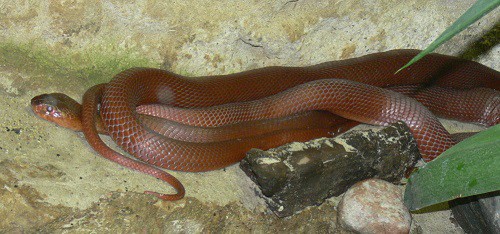
Everyone would like to think that their reactions are fast enough and their feet nimble enough to dodge a spitting cobra mid-spray. With the red spitting cobra, such a dodge is almost impossible, as they’re able to accurately spit in a person’s eyes from 2.5 metres away. The game isn’t over even with a lightning fast sidestep, as red spitting cobras have the confirmed power to spit 40 times in 2 minutes.
The quantity per spit is extremely consistent, with no massive blobs followed by small droplets or vice versa. Each spit depletes 1.7% of the red spitting cobra’s venom gland (according to a 1999 study), before the snake is finally forced to slither off into the undergrowth and regenerate.
Even worse, the potency of the venom stays rock steady for the first 20 spits. By spit 40, the venom was significantly diluted, but until spit 20, the quantity of cytotoxins increased slightly, with each jet having the power to blind the victim for several days. The first 6 spits also have a mysterious protein with no toxic qualities, which could instead be designed to keep the stored venom fresh.
| 3 | Relatively small venom globules |
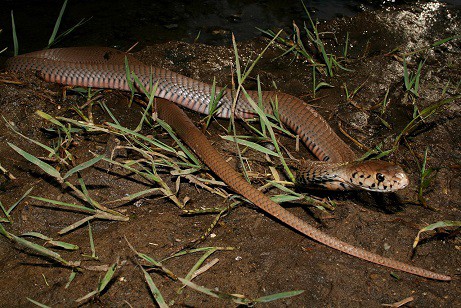
Among 4 species of African spitting cobra tested, the red spitting cobra (Naja pallida) ranked 3rd for spat venom quantity. The wet weight of the average spit was 2.64mg, but the black-necked spitting cobra managed 3.5 times higher at 9.75mg, while the Mozambique spitting cobra came in at 8.34mg.
All this suggests that if the snake gods forced you to choose one species to spit in your eye, you’d probably go for the red spitting cobra. But in other ways, their venom is worse. Red spitting cobras have higher quantities of anticoagulants than black-necks, toxins that deactivate blood clotting and trigger free bleeding. They also have a special neurotoxin which black-necks lack, making up 2.8% of red spitting cobra venom overall.
The main toxin of the two species is identical: Phospholipase A2 GL16-1, a cytotoxin which destroys cells via hydrolysis of phospholipids. Science has pinpointed the LD50 toxicity rating at 2mg, about equal to the black-necked spitting cobra at 1.15-2mg. The venom yield of a bite is 170-260mg, slightly below the black-neck’s 200-350mg. The figures are in: red spitting cobras aren’t the worst of their family, but they’re not to be trifled with.
| 4 | Given away by its black band |
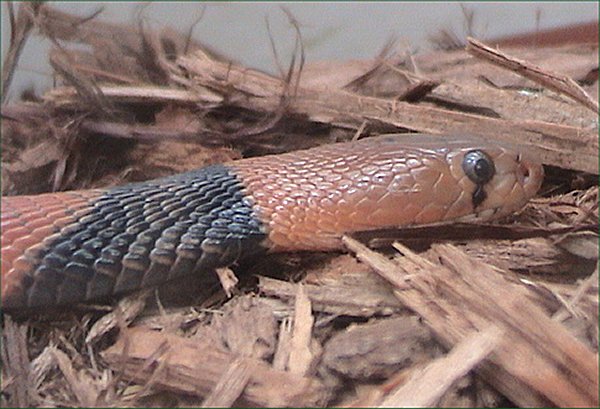
Red spitting cobras are very easy to recognise in Kenya, Ethiopia and other countries, mainly thanks to its classic red body. The colour isn’t 100% uniform, as they vary from moderate orange to bright red, with those further north a more consistent brick red. However, the red spitting cobra has no true lookalikes nearby. For example, the brown forest cobra has no hint of red, and a pale, even yellow belly. Its body is brown or black, sometimes with bluish tinges.
The red spitting cobra has 2 secret ID tricks, which remove all lingering doubts. The first is a single black band just below the head, circling around the entire neck like a scarf. The second is another pitch black scale just below the eye, contrasting sharply against the red scales and looking like an oily tear drop. Both features are usually present, and if they aren’t, the bright red colour almost certainly will be.
Red spitting cobras are a medium length snake at 70-150cm, with a record length of 1.9 metres. Their fangs are 4.5mm with a base width of 1mm, and the head is only slightly thicker than the neck. Their eyes are grey to almost fully black, with round pupils rather than vertical. Red spitting cobras are slender rather than thick-bodied, because of their nimble, spray-happy tactics which eliminate any need for constriction.
| 5 | An old friend of Steve Irwin |
One of the less known adventures of Steve Irwin happened in 2000, when he crossed over into red spitting cobra country and lived to tell the tale. The encounter took place on a rocky outcrop overlooking lush green forests, and began with Irwin charging up the rocks in hot pursuit of a fast and nimble cobra just ahead.
Near the summit, he finally seized its tail, and began waggling his black backpack around with his free hand. His goal was to create a distraction, and to his luck, the cobra fell for the ruse, spitting hard against the bag before getting confused and spitting in the opposite direction.
“They’re quite aggressive actually once they get riled up” said Irwin as he manipulated the snake’s tail. “You see that, he was gonna bite me”, he said affectionately, as the snake tried furiously to angle itself properly. Irwin was wearing a very thick and wide pair of sunglasses, but nothing more than shorts lower down. He was more at the red spitting cobra’s mercy than he realised, but when he released its tail, the snake raised its chest in one final display of warning, before slithering away across the dusty rock.
| 6 | Highly reliant on vision for hunting |
Scientists in a 1997 study were wondering which senses the red spitting cobra relies on to hunt. So they took a simple shortcut and tied a blindfold around 5 Naja pallida adults bred in captivity. Without the blindfold, the cobras lunged quickly, efficiently, and clung onto mice until they died. With the blindfold, they were reduced to a fumbling, mummy-like shuffle.
The red spitting cobras immediately began flecking their tongues more, defaulting to chemosensing, but this wasn’t enough to compensate for the loss of vision. Strike distance from prey was reduced, they took longer to commit to a strike, and they also moved around more, making wide sweeping motions of the head. Some of the blindfolded cobras only struck when they made actual contact with the mice.
The experiment proved that red spitting cobras hunt with their eyes, and not with their noses. Other snakes have different styles, like the Saharan horned viper, which tunes into vibrations in the desert sand where it lies buried.
| 7 | Patrols the parched Kenyan countryside |

Red spitting cobras are most abundant in dry savannah and arid grasslands, including rocky outcrops, as Steve Irwin discovered to his horror (which was actually delight). They have no overlap with the Mozambique spitting cobra to the south (common in South Africa). However, they may be a slight overlap with the black-necked spitting cobra to the west (Nigeria’s main one).
Younglings are active during the day, but adults are nocturnal, possibly because their vision has sharpened with age. Their favourite midnight hidey holes include termite mounds, mammal burrows, and rock piles, similarly to the black-necked spitting cobra.
One place which meets all those requirements is Tsavo East National Park in Kenya. This biodiversity hub is very flat compared to the more mountainous Tsavo West National Park (as red spitting cobras dislike high altitude), and is bursting with a colourful cast of animals, including the “big 5” iconic mammals of Africa: elephants, leopards, buffalo, black rhinos, and lions. There’s also dozens of bird species, including ostriches, parrots, and falcons, with gangs of hungry hyenas silhouetted against the horizon. The red spitting cobra slithers around stealthily while everyone else is distracted.
| 8 | The annual frog buffet |
From June to October, the heart of Kenya is a bone dry place, but when the heavens open during rainy season, the landscape totally transforms. Gallons of rain turn the ground from brown to green, soil changes into mud, and new ponds and lakes suddenly appear from nowhere.
Most importantly, armies of frogs and toads come out from hiding, and spring around all over the place to a constant chorus of crickets. During this wet period, the red spitting cobra also comes out in force, unable to resistant the bountiful food supply. Like the Mozambique spitting cobra, toads and frogs are one of their dietary staples, and they’ll sometimes climb trees or infiltrate standing water tanks by homes to get them.
A species they’re confirmed to eat is foam-nest tree frogs (probably the Peter’s foam nest tree frog), and this liking for frogs is why red spitting cobras are usually found near water bodies. They’ll also eat the house mouse (Mus musculus) in captivity, and they share a lizard prey with the black-necked spitting cobra: Amara amara, AKA the common amara, a blue-coloured 15cm reptile.
| 9 | Trigger happy hatchlings |
As adults, red spitting cobras are more like ultra cautious assassins. They’re very focussed spitters and only fire once the target is within the achievable spitting range of 2.5 metres. Hatchlings are the opposite: unpractised and completely wild with the venomous spraying. A 2009 study analysed the behaviour of 19 Naja pallida hatchlings, and found them so aggressive that they tried to spray the scientists before they’d even left their eggs. The hatchlings were in no rush to leave the eggs, sometimes spending 24 hours with their lower bodies coiled inside.
The young red spitting cobras had no discrimination about their targets, firing venom at scientists, the sides of their cages, and even the other hatchlings. Adult red spitting cobras always go for the eyes first, but the hatchlings shot at the stomach or any body part. The crazed hatchlings fired again and again at targets well outside their spitting range, giving no thought to accuracy.
This mad behaviour lasted until day 4-5, when the younglings shed their skin (edysis) for the first time. Afterwards, they suddenly matured. The scientists also measured the distance a youngling could spit at with accuracy, which was 54.5cm versus 2.5 metres for a red spitter adult. By day 10, the distance began to rise.
| 10 | Why dodging is almost impossible |
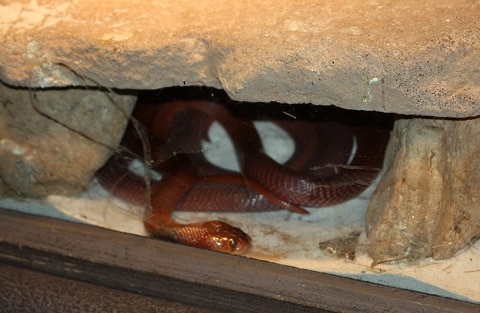
In 2009, a study revealed just how impossible a dodge would really be. Bruce Young of the University of Massachusetts strapped a thick transparent visor to his eyes, alongside an accelerometer to track his head movements. Over 6 weeks, a gang of red spitting cobras spat in his face over 100 times.
The scientists noticed how certain things set the spitting cobras off, most consistently a sudden head twitch, which the cobras used to anticipate his line of travel. The spitting cobras were able to analyse and predict Young’s exact future location in a matter of milliseconds.
The bone chilling footage was recorded with a 500FPS videocamera, roughly 20 times more detailed than average videocamera. The footage also revealed that red spitting cobras make a hard head twitch of their own before firing. This twitch was in line with the direction that the predator’s (AKA Young’s) eyes initially moved in. The point of the wiggle was to disperse venom over a wider area, as it only takes a single tiny droplet to cause instant, incapacitating pain. Theoretically, giving Naja pallida an epic staredown might be safer than turning and running.
| 11 | Installs homing beacons in prey |
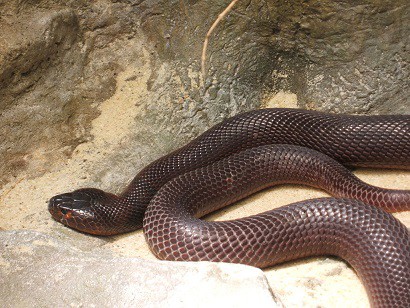
Naja pallida is an extremely accurate spitter, but this depends on their frame of mind. Scientists have found that highly agitated spitting cobras tend to lose their focus, targeting random moving objects and even their own reflections in the mirror. The crazy younglings, meanwhile, are the opposite; the study above found that being threatened made them more accurate.
There’s still some secrets with this species. All African spitting cobras produce their sprayed and fang-injected venom using the same gland, but the sprayed venom passes through an extra accessory gland. Scientists believe that this diversion may add an extra toxin or two to the final recipe, perhaps to make it optimal for blinding people.
What is known is a special hunting trick that red spitting cobras use. After they inject prey with venom, they’ll forgo their usual reliance on vision for hunting. Instead, the red spitting cobra will switch to chemosensing, and sniff out their own venom as the prey tries to escape, like a homing beacon forcibly implanted into a criminal so that the FBI can always track him after a jailbreak.
